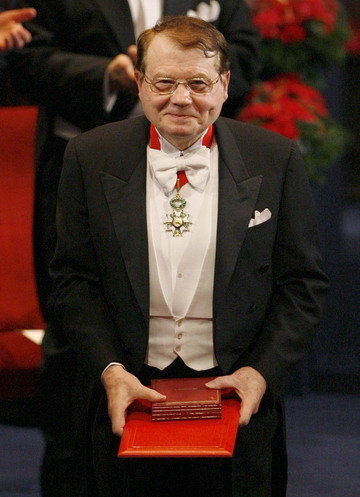Japan's Osamu Shimomura and Americans Martin Chalfie and Roger Tsien shared the chemistry prize for discovering and developing a fluorescent protein. Their work has helped researchers track such processes as the development of brain cells, the growth of tumors and the spread of cancer cells.
 |
|
Luc Montagnier of France reacts receiving the 2008 Nobel Prize in Medicine at the Concert Hall in Stockholm December 10, 2008. The medicine prize was given to three researchers, with Montagnier and Francoise Barre-Sinoussi of France awarded one half for their discovery of the "human immunodeficiency virus" and Harold zur Hausen of Germany awarded one half for his discovery of "human papilloma viruses causing cervical cancer". [Agencies]
|
Japanese scientists Makoto Kobayashi and Toshihide Maskawa split the physics award with American Yoichiro Nambu for theoretical advances that help explain the behavior of the smallest particles of matter. Nambu, 87, canceled his trip to Stockholm for health reasons and was set to receive his award at a ceremony in Chicago.
US economist and New York Times columnist Paul Krugman won the Nobel Memorial Prize in Economic Sciences for his analysis of how economies of scale can affect international trade patterns. The prize is not one of the original Nobels, but was created in 1968 by the Swedish central bank in Nobel's memory.
In a speech to hundreds of guests at a banquet following the prize ceremony, Krugman recalled getting the call from the Nobel award committee and thinking it was an "elaborate practical joke."
But as reality sank in "what I felt was not pride but a sense of astonished humility," he said.
The prizes _ including a diploma and a gold medal _ are handed out December 10 to mark the anniversary of Nobel's death in 1896. The inventor of dynamite died in San Remo, a link that the Italian city marks by sending flowers to the ceremony.
Associated Press writers Louise Nordstrom and Malin Rising contributed to this report.

